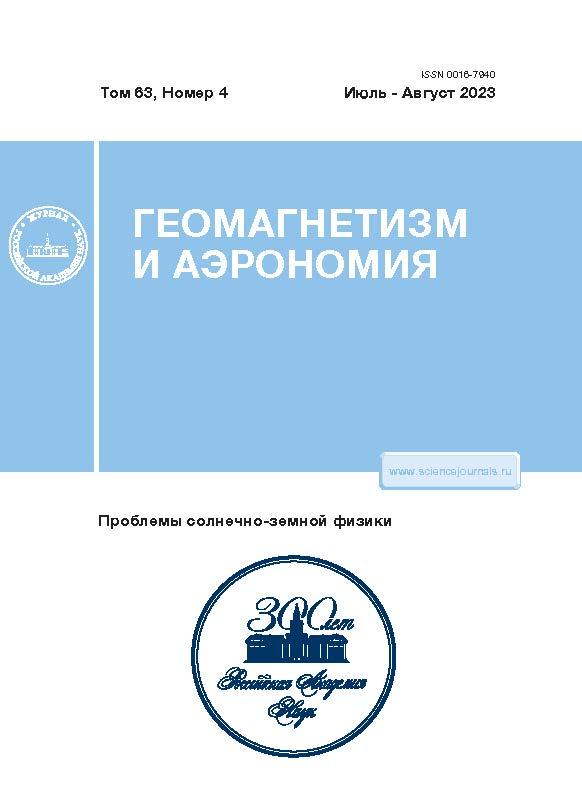Isolated Solar Cosmic Ray Events Caused by Energetic Storm Particles (ESPs)
- 作者: Bazilevskaya G.A.1, Daibog E.I.2,3, Logachev Y.I.2
-
隶属关系:
- Lebedev Physical Institute, Russian Academy of Sciences
- Skobeltsyn Institute of Nuclear Physics, Moscow State University
- 期: 卷 63, 编号 4 (2023)
- 页面: 503-510
- 栏目: Articles
- URL: https://ruspoj.com/0016-7940/article/view/651004
- DOI: https://doi.org/10.31857/S0016794023600254
- EDN: https://elibrary.ru/ONBCTQ
- ID: 651004
如何引用文章
详细
Based on the catalogs of solar proton events for the 23rd and 24th solar cycles, events were chosen
that lacked a reliable source of particles but were accompanied by interplanetary and geomagnetic disturbances.
As a rule, these events involve small proton fluxes that are detected near the Earth. All of the selected
events occurred during the arrival of shock waves to the Earth, suggesting that they were likely caused by the
arrival of energetic storm particles. It has been shown that flares accompanied by coronal mass ejections,
which occurred tens of hours before the onset of the increase in particle fluxes in Earth’s orbit, could be the
source of these events. The selected events exhibited several specific features. Only one of them was accompanied
by a single shock front, while the others had two or three shock waves. The time profile of the events
resembled a structure bounded by two shock fronts, suggesting that the shock waves likely accelerated and
confined the particles within a limited region of space.
作者简介
G. Bazilevskaya
Lebedev Physical Institute, Russian Academy of Sciences
Email: bazilevskayaga@lebedev.ru
Moscow, 119991 Russia
E. Daibog
Skobeltsyn Institute of Nuclear Physics, Moscow State University;
Email: daibog@srd.sinp.msu.ru
Moscow, 119991 Russia
Yu. Logachev
Skobeltsyn Institute of Nuclear Physics, Moscow State University
编辑信件的主要联系方式.
Email: logachev@srd.sinp.msu.ru
Moscow, 119991 Russia
参考
- – Капорцева К.Б., Шугай Ю.С. Использование DBM модели для прогноза прихода корональных выбросов массы к земле // Космич. исслед. Т. 59. № 4. С. 315–326. 2021. https://doi.org/10.31857/S0023420621040026
- – Крымский Г.Ф. Регулярный механизм ускорения заряженных частиц на фронте ударной волны // Докл. АН СССР. Т. 234. № 6. С. 1306–1308. 1977.
- – Кузьмин А.И., Филиппов А.Т., Чирков Н.П. Крупномасштабные возмущения солнечного ветра и ускорение космических лучей в межпланетной среде // Изв. АН СССР. Сер. физ. Т. 47. № 9. С. 1703–1707. 1983.
- – Логачёв Ю.И., Базилевская Г.А., Вашенюк Э.В. и др. Каталог солнечных протонных событий 23-го цикла солнечной активности (1996–2008 гг.). Москва – 2016. http://www.wdcb.ru/stp/data/SPE/katalog SPS 23 cikla SA.pdf. 2016. https://doi.org/10.2205/ESDB-SAD
- – Логачёв Ю.И., Базилевская Г.А., Власова Н.А. и др. // Каталог солнечных протонных событий 24-го цикла солнечной активности (2009–2019 гг.). М.: Мировой центр данных по солнечно-земной физике. 970 с. 2022. https://doi.org/10.2205/ESDB-SAD-008
- – Ameri D., Valtonen E., Al-Sawad A., Vainio R. Relationships between energetic storm particle events and interplanetary shocks driven by full and partial halo coronal mass ejections // Adv. Space Res. V. 71. № 5. P. 2521–2533. 2022. https://doi.org/10.1016/j.asr.2022.12.014
- – Barnard L., Owens M.J., Scott C.J. et al. Quantifying the uncertainty in CME kinematics derived from geometric modeling of heliospheric imager data // Space Weather V. 20. e2021SW002841. 2022. https://doi.org/10.1029/2021SW002841
- – Bell A.R. The acceleration of cosmic rays in shock fronts – II // Monthly Notices of the Royal Astronomical Society V. 182. P. 443–455. 1978.
- – Brueckner G.E., Howard R.A., Koomen M.J. et al. The Large Angle Spectroscopic Coronagraph (LASCO) // Sol. Phys. V. 162. P. 357–402. 1995.)https://doi.org/10.1007/BF00733434
- – Bryant D.A., Cline T.L., Desai U.D., McDonald F.B. Explorer 12 observations of solar cosmic rays and energetic storm particles after the solar flare of September 28, 1961 // J. Geophys. Res. V. 67. № 13. P. 4983–5000. 1962. https://doi.org/10.1029/JZ067i013p04983
- – Chiappetta F., Laurenza M.L., Lepreti F.L, Consolini G. Proton Energy Spectra of Energetic Storm Particle Events and Relation with Shock Parameters and Turbulence // Astrophys. J. V. 915. № 1. Art. № 8. 2021. https://doi.org/10.3847/1538-4357/abfe09
- – Cohen C.M.S., Christian E.R., Cummings A.C. et al. Energetic Particle Increases Associated with Stream Interaction Regions // The Astrophysical J. Supplement Series V. 246. Issue 2. id.20. 10 p. 2020. https://doi.org/10.3847/1538-4365/ab4c38
- – Decker R.B. The modulation of low-energy proton distributions by propagating interplanetary shock waves – A numerical simulation // J. Geophys. Res. V. 86. P. 4537–4554. 1981. https://doi.org/10.1029/JA086iA06p04537
- – Ebert R.W., Dayeh M.A., Desai M.I., Jian L.K., Li G., Mason G.M. Multispacecraft analysis of energetic heavy ion and interplanetary shock properties in energetic storm particle events near 1 au // Astrophys. J. V. 831:153 (21pp). 2016. https://doi.org/10.3847/0004-637X/831/2/153
- – Giacalone J. Energetic charged particles associated with strong interplanetary shocks // Astrophys. J. V. 761:28 (12pp). 2012. https://doi.org/10.1088/0004-637X/761/1/28
- – Gopalswamy N., Lara A., Lepping R.P. et al. Interplanetary acceleration of coronal mass ejections // Geophys. Res. Lett. V. 27. P. 145–148. 2000. https://doi.org/10.1029/1999GL003639
- – Kamide Y., Maltsev Y.P. Geomagnetic storms in Hand book of the Solar Terrestrial environment. Ed. Y. Kamide, A. Chain: Springer. 356–377, 2007. https://doi.org/10.1007/978-3-540-46315-3
- – Lario D., Hu Q., Ho G.C., Decker R.B., Roelof E.C., Smith C.W. Statistical properties of fast forward transient interplanetary shocks and associated energetic particle events: ACE observations // Proc. Solar Wind 11 – SOHO 16 “Connecting Sun and Heliosphere”, Whistler, Canada 12–17 June 2005 (ESA SP-592, September 2005).
- – Shi Y., Chen Y., Liu S. et al. Predicting the CME arrival time based on the recommendation algorithm // Research in Astronomy and Astrophysics V. 21. № 8. 190 (16pp). 2021. https://doi.org/10.1088/1674-4527/21/8/190
- – Suresh K., Gopalswamy N., Shanmugaraju A. Arrival Time Estimates of Earth-Directed CME-Driven Shocks // Sol. Phys. V. 297:3. 2022. https://doi.org/10.1007/s11207-021-01914-1
- – Zhao X., Dryer M. Current status of CME/shock arrival time prediction // Space Weather. V. 12. P. 448–469. 2014. https://doi.org/10.1002/2014SW001060
- − URL Wind https://www.lmsal.com/solarsoft/latest_ events_archive.html
- − URL CME https://cdaw.gsfc.nasa.gov/CME_list/
- − URL flares https://www.ngdc.noaa.gov/stp/space-weather/ solar-data/solar-features/ solar-flares/x-rays/goes/xrs/
- − URL IKI http://www.iki.rssi.ru/omni/
- − URL OMNI https://omniweb.gsfc.nasa.gov/form/ dx1.html
- − URL R&C https://izw1.caltech.edu/ACE/ASC/DATA/ level3/icmetable2.htm
- − URL SC https://www.obsebre.es/en/rapid#ssc
- − URL shock http://ipshocks.fi/database
- − URL Type II https://cdaw.gsfc.nasa.gov/CME_list/radio/waves_type2.html,
- https://www.ngdc.noaa.gov/stp/space-weather/solar-data/ solar-features/solar-radio/radio-bursts/reports/spectral-listings/Type_II/)











